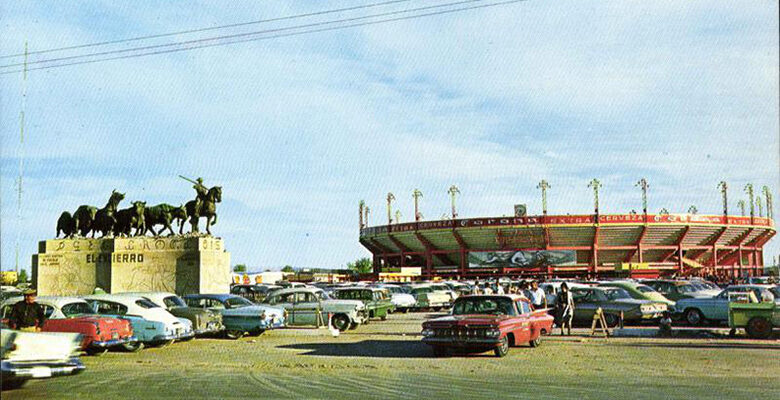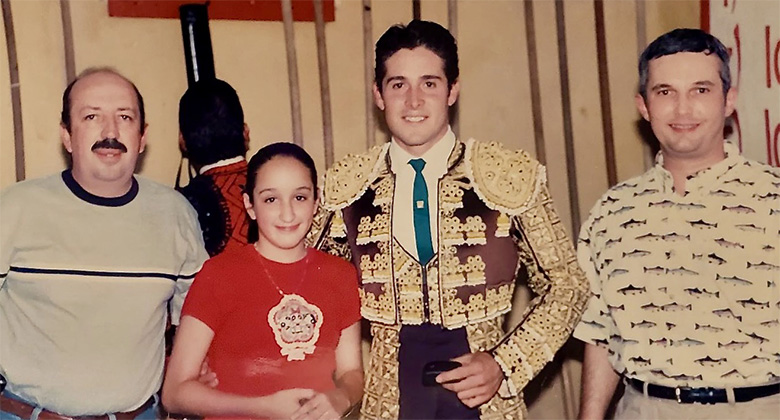By James Sawtelle
That Sunday afternoon I had time to cut loose and go with Richard Grenier (my high school friend) and his family to attend the bullfight in Juarez. It turned out to be one of the most tragic corridas that I have ever attended. Richard, his wife Marisa, his 12 year old daughter Christa, and his son picked me up in their silver grey Suburban. We took his son home because he detested the killing that occurs at the bullfights, and according to Richard and Marisa, we were all “much too boring for him.” We blissfully drove on and crossed the international bridge into Juarez and had an excellent almuerzo at Barrigas Mexican restaurant. Then on to Marisa’s father’s medical clinic to pick up her father, Dr. Santos, M.D. surgeon, and to tour his small, almost empty hospital next door that was up for sale. Dr. Santos was also the official bullring surgeon for the past 30 years and was marking his final year in that position. During the tour of the small, vacant hospital, we were about to leave when we stopped at one of the 13 small rooms that comprised the hospital, cupped our hands and peered in through the smoky glass. This was the same room where the legendary film actor Steve McQueen died many years ago, about 12 hours after Dr. Santos operated on his many massive malignant tumors. Steve McQueen died of a stroke that day. This room where he tragically died was surprisingly small and modest—even smaller than a university dorm room.
When we arrived at the Plaza Monumental Bullring I noticed that we were passing several attractive parking places without parking. I thought to myself, Richard, when in the heck are you gonna park? Richard drove us up to the tall wooden fence off one side of the bullring. Suddenly, the massive wooden gates swung open and we were waved into the VIP area. There were no more than a dozen vehicles parked there. We absorbed the area and watched the Picadors mount their horses. Then we showed our pass at the entrance of another outdoor fenced-in area and were admitted to the prefight VIP party. There we observed the headliner matador, and the two additional matadors, depart their prep area to briefly join our VIP party. Richard took me into the vacated prep area where women are prohibited from entering. We inspected the matadors’ chapel with its alter and grotto of the Virgin Mary, five Crucifixes, lit candles, and in the adjoining hall, the ER Trauma room. We returned to the party and were introduced to, and had our photograph taken with one of the three matadors of the afternoon.
We entered the bullring and found our seats on the third row in the middle of the shady side. We were so close the the action that you could literally reach out and touch the bulls. Seated nearby to our left was the elegant Ms. Zaragosa, who’s family owns the bullring. She was said to be worth $100,000,000.00.
Of the six bulls, they did a really good job with two of them. The other four were largely “ruined” by the mounted picadors by overdoing their pica thrusts directly into the bulls’ humps. During one attempted killing, matador 2 tried three times to push in his sword, or espada/estoque. But each time the sword bounced off of solid bone. Then they gave him the sword that has the special guard about 6 inches from the tip (estoque) and is targeted at the base of the skull, instead of the bull’s hump. With this sword he tried and failed four times to kill the bull. By then, many spectators were loudly taunting and jeering him. At that point, he lost all focus and composure. On his eighth killing attempt, during the moment of truth, the bull lifted his horn perfectly into the top center of the matador’s stomach and lifted him high–with the full weight of the matador squarely balanced on top of the horn–and tossed him like a wet rag. He curled up on the burnt orange dirt, clutching his wounded gut with an agony on his face like I’ve never seen on any man—except for a couple of times at the cinema.
The top matador then came out and promptly killed, or did a “descabellar”, to kill the bull with a descabello, (the specialized sharp hand knife which the (head) Matador uses to cut below the base of the bull’s scull to sever the spinal junction, ideally without the bull lifting its horns yet again). Sometime later, Dr. Santos returned to his position behind the barrier, his stethoscope still slung around his neck like a pro. By some miracle the bull’s horn did not penetrate the stricken matador’s skin. Instead it just caused probable severe injuries, and possibly even career-ending trauma. Biting our knuckles, we could almost feel the matador’s pain amidst our feelings of deep empathy. He was in fact the same Matador who had graced us with the group photo opportunity at the VIP reception only a short while earlier. Before the bullfight, we had asked Dr. Santos how many goring injuries, or cornadas, he had treated at the corrida during his years as the official bullring surgeon. He answered about 40, including one horse…make that 41.
Later, a local Juarez matador who had earned two ears on his first bull, was injured in his elbow by part of the horn (varetazo) of his second bull, and after a minute behind the barrier, he was barely able to continue. But continue he bravely did, though he could barely hold his muleta. Later, still in deep pain, he actually signed my seat cushion with his left hand—“For my friend Jim… 05-28-2000”.
Once, between bulls, during the middle of the bullfight, a bloody banderilla was removed from a dead bull and presented to me—the only one presented to a spectator during this bullfight, and with all eyes on me—all because Dr. Santos had asked someone to have that happen. Later while admiring my blood-soaked banderilla, I turned to the most stunning pair of happy señoritas sitting next to me, smiled and said, “Mirar!”



Here are the missing captions for my story above, The Last Corrida.
Caption for the top photo of the Plaza Monumental bullring:
The magnificent Plaza de Toros, Plaza Monumental, Juarez Mexico, during
its mid century golden age, Ca.1961. The grand bullring was subsequently razed, Ca. 2005.
Caption for the middle, group Matador, photo:
May 28, 2000: The author (far right) at one of the last great Spanish style bullfights at Plaza Monumental, Juarez Mexico, during the VIP meet and greet. One of the three Matadors (second from right) cordially introduced himself and welcomed us. One of the picadors (second from left, facing away) scrutinizing his pica options at the pica rack. Richard’s (far left next to his daughter Christa) father in law, Dr. Santos, (not shown) performed surgery on the late Steve McQueen in the same city several blocks away about 20 years earlier, ca. 1980. He also treated severe injuries that afternoon at the Bullring on at least one of the Matadors, especially the one seen in this photo who was tragically injured that afternoon during his second bull.